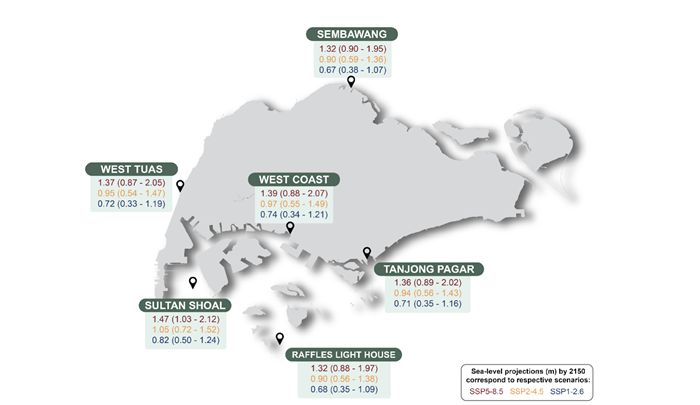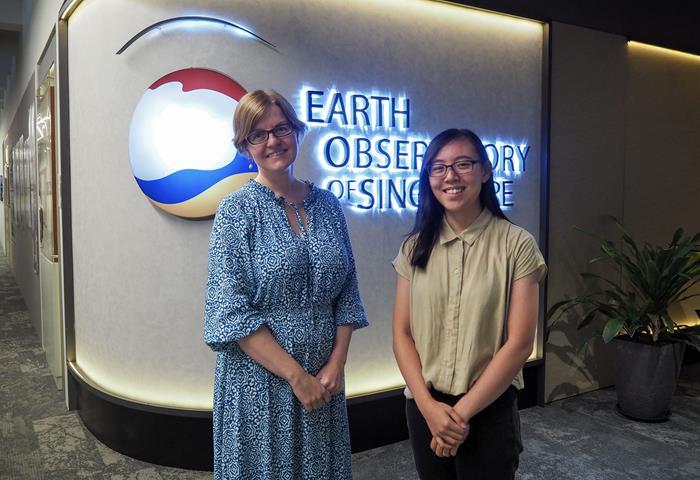Amongst the many impacts of climate change, sea-level rise emerges as a key threat to Singapore. As an island-nation, nearly one-third of Singapore is less than five metres above sea-level. One key aspect to increase the country’s resilience is to improve local sea-level projections, so appropriate adaptation measures can be put in place. Among other results, this is what the Third National Climate Change Study (V3) provides. Recently published by the Centre for Climate Research Singapore (CCRS) under the Meteorological Service Singapore, the study builds on a wealth of data and findings from a range of scientists, including from the Earth Observatory of Singapore (EOS).
EOS has had a long-standing collaboration with CCRS, and through its sea-level research, two students from the Asian School of Environment (ASE) and EOS at Nanyang Technological University Singapore (NTU Singapore) contributed to the study.
Using tide gauge data to derive sea-level projections
Ms Trina Ng, a PhD student at NTU’s ASE and EOS, and Research Scientist at CCRS, contributed to V3’s chapter on sea-level rise for Singapore. She worked on improving sea-level projections for the country.
V3 provides sea-level projections for three Shared Socioeconomic Pathways (SSP), which are different scenarios used to characterise possible future development for society, and encompassed projections of both medium and low confidence, which represent levels of agreement among studies and lines of evidence.
The sea-level projections were produced using the Intergovernmental Panel on Climate Change Sixth Assessment Report (IPCC AR6) methodology published in 2021. IPCC AR6 provided relative sea-level projections for six tide-gauges from around Singapore. While there are a total of 10 tide-gauge records in Singapore, only six have records spanning the minimum duration of 15 years to generate sea-level projections in AR6.
For V3, data from the six tide gauges were revised and reprocessed. “We used improved local tide gauge data to provide more reliable sea-level projections for Singapore and the region,” said Ms Trina Ng.

Projected relative sea-level rise at the six tide-gauges in Singapore, under the three emission scenarios. The values shown reflect the likely range of projected sea-level change by 2150, relative to IPCC AR6 baseline. (Source: Third National Climate Change Study (V3)/ Centre for Climate Research Singapore)
In V3, the mean sea level is projected to rise with medium confidence by 0.23 metres to 1.15 metres by 2100 and up to around 2 metres by 2150. This is higher than the sea-level rise projected in IPCC AR6, but comparable to the Global Mean Sea Level (GMSL) rise. Low confidence projections extend up until 2300 and could likely see 7 metres of sea-level rise by 2150 in Singapore under the high emissions scenario.
Land subsidence intensifies sea-level rise
V3 emphasised the importance of accounting for vertical land motion when studying the impacts of sea-level rise in the region. Land contributions to sea-level rise is a topic that has interested EOS scientists over the past few years.
A 2022 study led by Ms Cheryl Tay, a PhD student at NTU’s ASE and EOS, provided estimates of land subsidence across the world’s largest coastal cities. It demonstrated that Southeast Asia is experiencing fast rates of land subsidence, which sometimes surpassed the rate of mean sea-level rise itself in the past twenty years.
For example, the research team found that parts of Yangon, Myanmar, one of the areas studied by V3, are sinking as quickly as 30 millimetres (mm) per year. That is nearly ten times the rate of rising global mean sea-level, which is estimated around 3.5 mm per year based on data from 1993 to 2021. This means that along certain parts of Myanmar, the sea-level rise that coastal communities are seeing is mostly due to land subsidence.
Meanwhile, parts of Singapore were estimated to subside at a median rate of 1.4 mm/year. While less intense than the fastest-sinking cities, these rates still need to be factored into Singapore’s relative sea-level projection studies, as was highlighted in V3.

Professor Emma Hill, Principal Investigator (PI) at EOS and PI of the NSLP-funded project ‘Forecasting land-height change and coastal flooding using geodesy and remote sensing’ and Ms Cheryl Tay (right) (Source: Earth Observatory of Singapore)
“I am very grateful to see my research included in a national-level study, and it is rewarding to know that it can potentially contribute to policies and decisions,” said Ms Tay whose research was funded by the National Sea-Level Programme (NSLP) administered by CCRS.